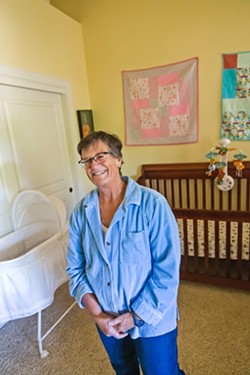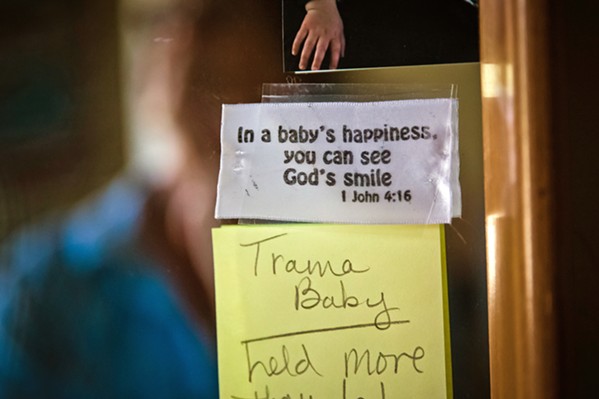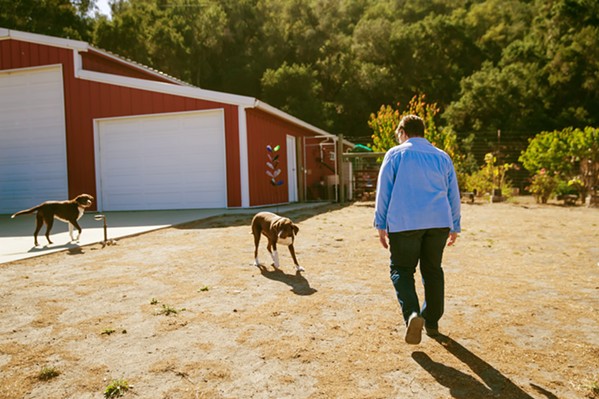When Atascadero mother Taylor saw her baby sit up for the first time over a video call, she feared she'd lost control of the situation.
"I was really worried that she was only going to know me as someone on a screen and forget how I sound. I really didn't want her to forget anything," she said.
Taylor was in her room at Bryan's House, a substance addiction recovery home, when her baby sat up for the first time in Maggie's Arroyo Grande home, where her daughter began receiving foster care a month after she was born.
Initially, Taylor met her daughter once a week under the guidance of Genii Myers-Sandoval, her counselor at Bryan's House, and Maggie, who requested her last name be kept anonymous. But the pandemic changed that. COVID-19 widened the physical gap between Taylor and her baby.
"As of March [2020], I was told all of a sudden that I would no longer be able to see her in person ... that it would be at least the next three months if not longer," said Taylor, who also requested anonymity. "I would just have to accept that I would have to visit with my daughter via Skype or Zoom. That was really tough for me, that was really heartbreaking."
Taylor and her daughter eventually reunited with the help of Child Welfare Services (CWS), Maggie and her family, and a slew of other service providers.
But the number of resource families like Maggie's dropped in San Luis Obispo County during the pandemic, and now that school is back in-person, an increasing number of calls reporting child abuse keep CWS phone lines busy.
Officials with CWS, which is managed by the county Department of Social Services, worry that traumatized children will have nowhere to go. They told New Times that roughly 270 children needed care when COVID-19 hit.
CWS Program Manager Roxi Selck said that many potential resource parents were nervous about children's medical history in the midst of COVID-19, which caused hesitation about volunteering to participate in the foster care system. Others, she said, didn't have the bandwidth to provide foster care because their older children who went away for college were forced to return for lockdown.
"We need homes desperately for the youth. Our typical means of recruitment [of resource parents] is in-person," Selck said. "But we've been cold-calling, emailing, and posting on social media. It's been really tough because it's easy to be out of sight, out of mind."
Modeling motherhood
Caregiving is intense. Looking after drug-exposed babies means unusually long hours of staying awake.

- Photo By Jayson Mellom
- TIRELESS CARE After her three daughters moved out, Maggie plunged right back into raising children in 2018 when she opted to be a resource parent for foster infants.
Maggie said that the substance exposure stresses out babies' nervous systems, which means the children she takes care of often can't do regular things, such as drink from a bottle. Along with taking care of infants, she's also tasked with mentoring their birth mothers who are battling addiction, as was the case with Taylor and her baby.
"Maggie showed me this incredible technique to get her to drink from the bottle. She would take her pointer finger and her thumb and squeeze [my daughter's] cheeks a little bit. [Then, Maggie] would place her middle finger under her [baby's] chin all while balancing the bottle in the same hand. Doing that helped my daughter figure out how to create that suction," Taylor said.
A resident of Arroyo Grande, Maggie chose to become a resource parent in 2018, soon after her three grown daughters moved out. After retiring from a long career as a school teacher, Maggie said she wanted to find another purpose in life.
But Maggie had some reservations before she dove into resource parenting. The thought of providing such care crossed her mind in 2015, and she spent the next three years researching and asking CWS questions. Though the process of being a resource parent is straightforward, Maggie said she finally had to stop doubting herself.
"I'm a Christian, and it was kind of like I needed to do this or God was going to find somebody else who would," Maggie said.
The ultimate goal of fostering is to reunite children with their birth families. Maggie wondered if she'd be pressured to adopt those she looked after as a resource parent. After two decades of raising her own children, she was tired.
"One of the promises I had made to my husband was we would not do this to adopt children. I still had love to give while he was still working, and I could still be home for the children we would be caring for," Maggie said. "Then I went for [resource parent] training and the first thing they said was, 'You're caring for drug-exposed children; they need a nice quiet place where they can heal, and you're not allowed to adopt them because you're mentoring the parents.'
"That falls right into my teacher line of work," Maggie said, "and I loved parenting. So I said, 'Sign me up!'"
People can become resource parents within 90 days once they decide to sign up. That includes time for CWS reviews, home inspections, and training sessions. Maggie said that the Department of Social Services also offers a dozen classes each month on specific topics. This was where she came across the specialized session for drug-exposed infants.
Maggie supplemented lessons with her own research. She gained additional help from a place most people visit when they're trying to learn a skill: YouTube. Maggie found solace in the channel A Fostered Life, hosted by Christy Tennant Krispin.

- Photo By Jayson Mellom
- 'LIKE ANGELS SINGING' A practicing Christian, Maggie dotted her nursery with short Bible verses that she would read every night to the infants she temporarily cared for.
"She was so valuable. She took you from the day you make your decision and is still making videos on foster care. [Her videos] were the most valuable things I ever watched," Maggie said.
As of 2021, Maggie has been a resource parent for more than three years and has looked after four babies. She is currently not looking after a child and plans to pause her license to spend more time with her daughters.
Until she's ready to look after infants in need again, Maggie's nursery in her serene Arroyo Grande home will be waiting.
The sun streams through big windows, falling on a white bassinet holding a bright pink pacifier. On the other side of the room, an animal-themed mobile hangs over the mattress of a dark-wood crib.
When she became a licensed caregiver, the room that used to belong to one of her daughters underwent thoughtful renovation. With quilts on the wall as centerpieces, a cushy armchair sits beside a basket brimming with children's storybooks, and photographs of the babies she's looked after sit atop a changing table.
"Our stress levels are much less than a new parent because we've done this three times," she said.
Maggie also placed a helpful tip for herself and her husband in the room. A sticky note on the nursery mirror reminds them: "Trauma babies need to be held more than six hours a day."
She said holding them for that long is necessary because the babies usually have an attachment disorder. That was especially true during the pandemic, which kept birth mothers and babies apart and made it harder for babies to receive skin-to-skin contact.
Taylor said she would send recordings of herself reading stories for Maggie to play to her baby because it was important for Taylor's daughter to recognize her mother's voice. The baby's day would end with Maggie reading Jeremiah 29:11—"'For I know the plans I have for you,' declares the Lord, 'plans to prosper you and not to harm you, plans to give you hope and a future'"—to her, while she also prayed for strength.
In one instance, after countless hours of patiently helping Taylor's baby to breathe easily, Maggie said her prayers seemed to have worked.
"You could hear the air all the way down her throat [when she gulped]. One day, she swallowed quietly," she said. "It was like the angels singing."
Clarion calls
Taylor and her baby reuniting is one positive outcome of a pandemic-battered foster care system. Not only are resource parents like Maggie few and far between, but the number of documented youth in care also dwindled.

- Photo By Jayson Mellom
- PERSONAL TOUCH Maggie transformed her daughter's her daughter's bedroom in her Arroyo Grande home into a nursery complete with plush toys and baby-proofed furniture.
"For two consecutive years pre-pandemic, we averaged 380 youth in care. As of June 2021, there were 262 youth in care," CWS's Selck told New Times.
Only 75 of the 262 children are under 5 years old. Teenagers make up the majority, and Selck said they're the most difficult to get housed because of the stigma of rebelliousness that comes with the age group.
"I've heard a lot of people say, 'Oh, I can't possibly expose my biological kids to a foster child because they're too messed up.' Foster kids are no different [from] any other child," Selck said. "They just suffered different traumas ... and being surrounded by a loving and supportive family is the best way for them to overcome that. All they really need is stability."
She said that most youth in need live in emergency shelter care homes and that the county is also facing a shortage of such spaces.
"That's when we really get backed into a corner, and we have to scramble. We have a youth coming into care, we don't have anywhere to put them, all of our shelter beds are full, ... it leaves the youths feeling unsettled," Selck said.
Both Selck and CWS's licensed family and marriage therapist, Mark Haas, said that the fluctuation in youth numbers occurred because COVID-19 lockdowns kept children out of the public eye.
"When kids stopped going to school and stopped participating in sports, ... less allegations of abuse were being reported," Selck said.
She added that schools are a place where authority figures can notice whether a child's behaving oddly. School officials are mandated by law to report suspicions of abuse. CWS also receives such calls from family members and the community at large—reports can be made "by anyone at any time." The department would then send staff members to investigate the complaint, sometimes with the help of law enforcement, according to Selck.
Though CWS experienced a lull in reports of abuse, Selck said that the organization noticed a worrying rise in the severity of the allegations that came in. Anecdotally speaking, she attributed the intensity of child abuse to the pandemic's tense atmosphere.
"When stress goes up because of sickness and loss of housing, the frequency of abuse is worse. Everything is magnified because of the volatile nature," Selck said.
With SLO County reopening schools in the midst of widespread vaccine availability, the calls reporting abuse have ticked up steadily.
"We used to receive about 400 calls per month. It reduced to 200 during the peak [of COVID-19]; it's creeping back up now," Haas said.

- Photo By Jayson Mellom
- QUALITY TIME Foster care babies can enjoy playtime in Maggie's spacious backyard while she tends to her chicken coop and keeps a watchful eye on them.
CWS isn't the only agency that experienced such a reporting trend. Christina Kaviani, the prevention and education director of Lumina Alliance—a local organization dedicated to ending sexual and intimate partner violence—told New Times that her office, too, noticed a rising number of service calls for child abuse.
But the onslaught of COVID-19 also caused a spike in a different set of callers: mothers seeking help for substance addiction. Such addiction issues are something Bryan's House—an Atascadero recovery home—is all too familiar with.
Helping hands
When husband and father Bryan Steve Wortley succumbed to his opioid addiction in 2010, his parents set up a recovery home named after him to help expecting and current mothers battle drug abuse. Now, five years since its inception, Bryan's House has helped numerous women, including those trying to regain custody of their children.
Bryan's House substance abuse counselor Myers-Sandoval told New Times that soon after the lockdown lifted, they started receiving calls from women who desperately needed intervention.
"During COVID-19, a lot of addicts lost their support. We had a lot of women relapse. They didn't have the resources because everything was shut down. They shut down NA [Narcotics Anonymous] meetings, too. They were at their own devices, and a lot of times, [that means] using again," Myers-Sandoval said.
All of Bryan's House's clients are assessed by Drug and Alcohol Services, and CWS also helps out with referrals. The recovery home can house six women and their children at a time, and services range from counseling and crisis intervention to instilling skills like financial management.
The pandemic was hard on everyone at Bryan's House, Myers-Sandoval said, but especially on women whose children were in foster care.
"Visits [with their children and resource parents] were being canceled all the time," she said. "So we actually set up Zoom so they could have face time with their children and do visits that way, but it just was not the same at all."
Myers-Sandoval added that Bryan's House staff usually drove mothers to visit their children and receive mentorship. But that stopped during the pandemic, too, because of infection risks. Taylor was one of Myers-Sandoval's clients who had to resort to intermittent video calling with her baby and Maggie. Though they eventually reunited, the pandemic delayed Taylor's way back to her child.
"We would try really hard to get all the moms to their visits, but sometimes they just had to miss them. It seemed to slow up their progress with reunification; it put a standstill on that for some of them," Myers-Sandoval said.
Taylor experienced the stop-start nature of hope that came with the uncertainty of the pandemic.
"There were a couple of times I was told that the reunification process would start, and my daughter would be back in my care. Then, the day it was supposed to start, I was told it would be extended. CWS was trying to figure out how to work with COVID and how to safely reunite mothers with their children," Taylor said.
Taylor's baby was born in December 2019. CWS put her in Maggie's care a little more than a month later, after Drug and Alcohol Services contacted Taylor. Either Myers-Sandoval would drive Taylor to visit Maggie, or the resource parent and the baby would arrive at Bryan's House for mentoring.
Some of the exercises like the bottle feeding lesson had begun a few weeks before the pandemic hit. The mentoring sessions screeched to a halt when SLO County locked down in March 2020. By the time they restarted a few weeks later, the world had moved to online classes.
Taylor said the video visits were tough because not only did she have to continue learning through video calls, but she also had to adjust without the physical presence of her baby. In spite of these hardships, Taylor is grateful for Myers-Sandoval's counseling.
"I cried on her shoulder multiple times. She would sit with me and Maggie, and helped me try to figure out different things that were unique to caring for my daughter, like techniques to put her to sleep," she said.
Taylor reunited with her baby in August 2020 and lived in Bryan's House for nine months until February 2021.
Her journey to sober living with her child shows that no one person acted alone when lending help. CWS worked with numerous partner groups like the recovery home, CAPSLO, and other agencies who made sure that along with getting sober, Taylor attended all her court appointments in time and even got housed.
Bryan's House also later hired her as a peer support member. She started work the weekend of Oct. 23.
"They taught me how to parent, and to handle the ups and downs when you're trying to get reunified with your child," Taylor said. Δ
Reach Staff Writer Bulbul Rajagopal at [email protected].

Comments